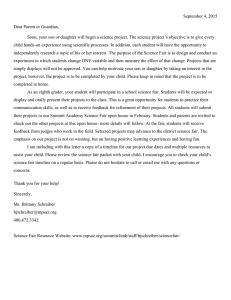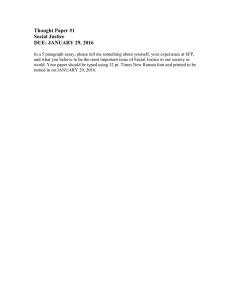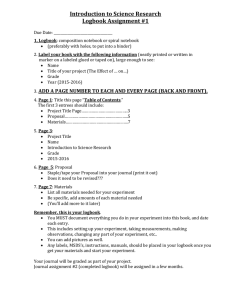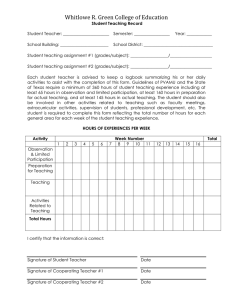7 Grade Science Fair Packet
advertisement
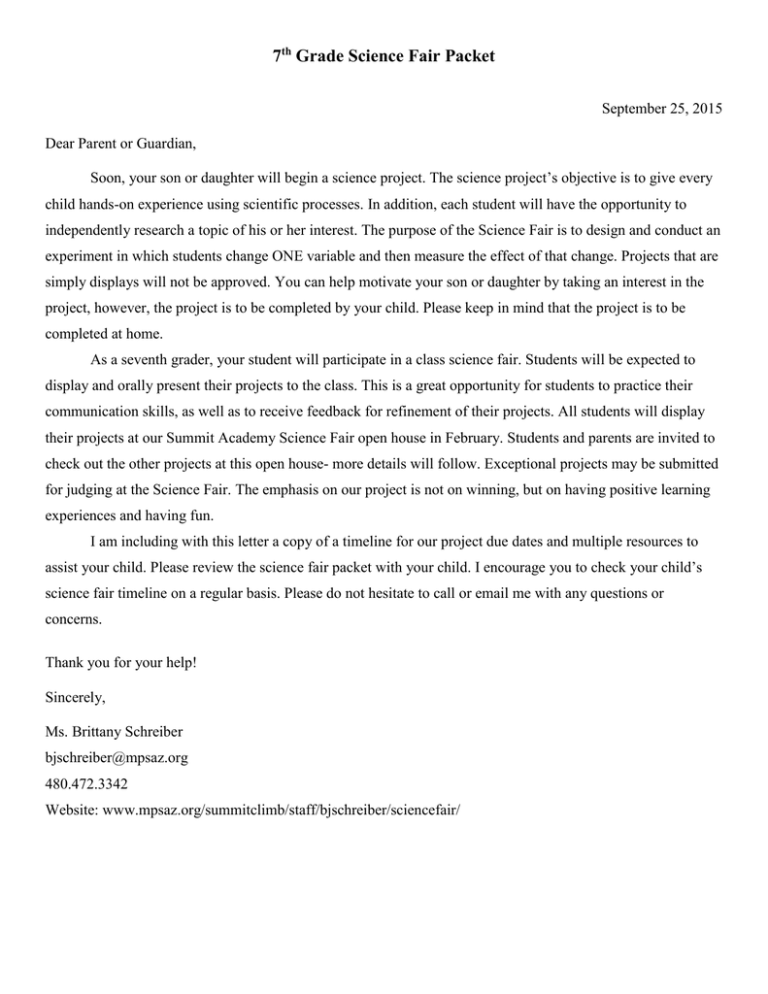
7th Grade Science Fair Packet September 25, 2015 Dear Parent or Guardian, Soon, your son or daughter will begin a science project. The science project’s objective is to give every child hands-on experience using scientific processes. In addition, each student will have the opportunity to independently research a topic of his or her interest. The purpose of the Science Fair is to design and conduct an experiment in which students change ONE variable and then measure the effect of that change. Projects that are simply displays will not be approved. You can help motivate your son or daughter by taking an interest in the project, however, the project is to be completed by your child. Please keep in mind that the project is to be completed at home. As a seventh grader, your student will participate in a class science fair. Students will be expected to display and orally present their projects to the class. This is a great opportunity for students to practice their communication skills, as well as to receive feedback for refinement of their projects. All students will display their projects at our Summit Academy Science Fair open house in February. Students and parents are invited to check out the other projects at this open house- more details will follow. Exceptional projects may be submitted for judging at the Science Fair. The emphasis on our project is not on winning, but on having positive learning experiences and having fun. I am including with this letter a copy of a timeline for our project due dates and multiple resources to assist your child. Please review the science fair packet with your child. I encourage you to check your child’s science fair timeline on a regular basis. Please do not hesitate to call or email me with any questions or concerns. Thank you for your help! Sincerely, Ms. Brittany Schreiber bjschreiber@mpsaz.org 480.472.3342 Website: www.mpsaz.org/summitclimb/staff/bjschreiber/sciencefair/ Summit Academy SC19 Science Fair Information As a student in the advanced science class, you are required to complete a science fair project. You will need to spend time out of class on your project. In class work time is limited; therefore, I encourage students/partners to attend help sessions regularly. You will be graded on each step of the project as it is completed. There are due dates throughout the year in which components of your project must be submitted. If you complete all steps of the project and have all required parts by the turn in date of January 27, 2016, your project will be entered for display in the Summit Academy science fair open house. Especially well done projects may be selected for judging. If your project places, then it may be entered into the Mesa Public Schools District Science Fair on Thursday, February 19-20, 2016. If your project places first for the district in its category, it will be entered into the Arizona State Science Fair. Your science fair project must adhere to the Arizona State Science Fair (AzSEF) and ISEF rules and regulations. If you are truly serious about placing, you must see the ISEF website for their rules and regulations. [https://student.societyforscience.org/internationalrules-pre-college-science-research] If you do not adhere to their guidelines, your project cannot be entered in their fair. The purpose of the Science Fair is to design and conduct an experiment in which you change ONE variable and then measure the effect of that change. As you think of possible topics, consider what it is you will be changing and what you will be measuring as a result of that change. Topics that will NOT be approved: Most mold/bacteria projects Projects designed to kill vertebrate animals, toxicity studies using vertebrate animals, improper treatment of animals ***Projects using human subjects have very strict guidelines and will need to submit paperwork to the SRC prior to beginning the project. Please see the ISEF website above for details*** Notice: As a general rule in science, do not use personal pronouns for any part of the Science Fair. Science Fair Due Dates *Dates subject to change. I encourage all students to attend help sessions for additional assistance. Date Due Assignment Format Thursday, Oct. 1, 2015 Signed Partner and Safety Agreements Monday, Oct. 5, 2015 Project Ideas: 3 Testable Questions Loose Leaf Notebook Paper Thursday, Oct. 22, 2015 Background Research and Work Cited page Typed Tuesday, Oct. 27, 2015 Testable Hypothesis, Experimental Design Chart, Materials, and Procedures with Parent Signature (Testing may begin once Experiment Design and Procedures are returned and signed off by Ms. Schreiber) Typed Tuesday, Nov. 10, 2015 Prior Research Paper Typed Monday, Dec. 7, 2015 Completed Data Table(s) - all testing is completed! Handwritten- will type in class Thursday, Dec. 10, 2015 Data Tables, Graph(s), and Data Analysis Typed Friday, Jan.8, 2016 Conclusion Typed Wednesday, Jan. 13, 2016 Abstract Typed Wednesday, Jan. 27, 2016 Project Display Boards and Logbooks DUE- begin oral presentations. Everything is TypedNo Personal Pronouns! Wednesday, Feb. 10, 2016 Summit Academy Science Fair Open House 4:00-5:30 pm Feb. 19-21, 2016 MPS District Science Fair During School Signed Document ***Help is available during weekly tutoring hours- Wednesday after school from 3:504:30 pm, however, additional help times may be scheduled with me.*** Science Fair Required Elements (All work is to be completed in your logbook!) 1. Logbook: folder with prongs so papers may be added or rearranged as needed. All ideas, notes, and data collected should be recorded in the logbook. It must be handwritten, not typed. Logbooks serve as evidence that the students completed the project. Science fair projects cannot be submitted without a logbook. Students who choose to work in groups still need an individual logbook for each member. All logged entries must include date, time, and topic of discussion for each session. Students should record all information, research, and data in the logbook. A logbook should also include a table of contents with three columns. The columns are the topic, page number, and date of completion. Each step of the science fair is to be recorded in the logbook. A safety contract or a reference to safety should be in your logbook. 2. Topic Approval Students should submit a testable question and two back-up questions aligned with the topic category for each. Students who decide to work with a partner must also include an agreement contract that outlines the responsibilities and work time. The Partner Agreement Contract form must be signed by parents of both students. Be sure to avoid any personal pronouns when writing the question. Science Fair Categories Behavioral and Social Sciences Cellular and Molecular Biology Chemistry Computer Science Earth and Planetary Science Engineering Environmental Science Mathematical Science Medicine and Health Physics and Astronomy Plant Sciences 3. Background Research and Work Cited What research did you do to better understand your topic? You may use books, magazines, and online resources to find your information. All information must be cited correctly. I suggest using the MPS databases for information and using NoodleTools.com to create your work cited page. Cite your sources as you use them. Do not wait until the end of the project to start your work cited page. Use the provided template to complete this portion of your science fair project. 4. Testable Hypothesis A hypothesis should be your prediction about the independent and dependent variable. It will often be written in the “If…then…” format. It should include both variables and should answer your scientific question. 5. Experimental Design Chart The chart must include the independent variable, control and experimental groups, dependent variable, and any controlled variables (min. 3). (Template provided). You need to clearly identify each on your display board. 6. Procedures and Materials List Describe the procedures that you will follow to complete your experiment. Use the correct format for writing procedures, (steps numbered on the left side, start each step with a verb, avoid transition words, do not use personal pronouns, etc.) These steps must be followed exactly during your experiment. You must record any necessary changes. List all materials in a bulleted form. Include safety rules to follow during your experimentation. The Procedures and Materials section must be signed off by your parent before you turn it in to me, and must be signed off by me before you begin any testing! 7. Prior Research Paper Explains why your project is interesting and relevant. Explains what you found in your research and how it is related to your experiment. An additional paper will be provided to outline this section of your project. 8. Data Table and Graph All data should be measured in metric. Data that does not follow this criteria will not be accepted. Be sure to use a data table to organize your data. Create a graph to best represent your data. Remember to properly label your data table and graph. 9. Data Analysis You will describe and explain your results. You need to explain the relationship between the IV and DV. Interpret your data- what does the data mean? Compare the data to the control(s) and explain any outlying data (extraneous variables). Discuss sources of uncertainty or unexpected results. Also, add anything else pertinent to the experiment that is being conducted. 10. Conclusion Restate your hypothesis and whether it was supported or not supported by the results. Explain what evidence shows whether the hypothesis was supported or not. Evaluate the effectiveness of your procedures. Describe extensions or improvements to your investigation. 11. Abstract An abstract provides an overview or summary of the project. It should emphasize why this experiment is important for others to be aware. The abstract must be typed and should describe the student’s conclusions in 250 words or less. The abstract will be attached to the display board. It will be the first component of your display board. 12. Display Board The display should contain all parts of the scientific process. Use of a commercially available display board is strongly recommended. Displays are limited to 30in deep, 48in wide, and 108in high. Most are considerably smaller. Your display should stand on its own. Lettering should be neat and uniform and spelling should be accurate. The attractiveness of the display is important. Use of personal pronouns anywhere on the display board is not permitted. Please be sure to follow this rule from the beginning to avoid major edits later on. Some class time will be spent in class covering what a display board should look like and techniques for properly putting a display board together. Additional help after school will be available for students who wish to have additional support when building their display. Experimental Design Chart Analysis Conclusion and future research Work cited *Sample set-up 13. Conventions Did you proof read your work? Did you run a spell check and grammar check? No personal pronouns are allowed on your board! 14. Oral Presentation You will have a brief period of time to present your project to your class. Practice, practice, practice! Use flashcards if needed. 15. Science Fair Set-up instructions will be provided by your teacher before the fair. *This project is to be completed at home. I strongly encourage students to attend help sessions for additional assistance. Background Research Making a Background Research Plan: How to Know What to Look For Background research is necessary so that you know how to design and understand your experiment. To make a background research plan -- a roadmap of the research questions you need to answer -- follow these steps: 1. Identify the keywords in the question for your science fair project. Brainstorm additional keywords and concepts. 2. Use a table with the "question words" (why, how, who, what, when, where) to generate research questions from your keywords. For example: Throw out irrelevant questions. You can always find more information to research, but some questions just don't have anything to do with the experiment you will define and perform. Questions that will help you design and understand your experiment are called relevant. Questions that will not help you design and understand your experiment are called irrelevant. Our table of question words is a great way to generate ideas for your background research, but some of them will be irrelevant and we just throw those out. Some of those irrelevant questions might be very interesting to you; they just don't belong as part of your science fair project. We have to focus our efforts on what we feel is most important, or another way of looking at it, let's not spend time researching anything we don't need to. (I'm sure you have other things you'd like to do, too!) 3. Add to your background research plan a list of mathematical formulas or equations (if any) that you will need to describe the results of your experiment. 4. You should also plan to do background research on the history of similar experiments or inventions. 5. Network with other people with more experience than yourself: your mentors, parents, and teachers. Ask them: "What science concepts should I study to better understand my science fair project?" and "What area of science covers my project?" Better yet, ask even more specific questions. Identifying Keywords The place to start building your background research plan is with the question for your science fair project (see, we did that first for a reason). Let's imagine that you have asked this one: Question: Does drinking milk help decrease spiciness better than water or Pepsi? Begin by identifying the keywords and main concepts in your question. In this case keywords would be: Milk Spiciness Pepsi Water Question Words Table Filling in a little table can help. Let's do it for our keyword spiciness: Fill Your Keywords (or Variations on Your Keywords) into the Blanks These are just samples to get you thinking; there are always many more questions and the most important ones for your project may not be in the list! Possible Questions for Background Research Relevant? Why Why does ________ happen? Why does ________ ________? Why does spiciness happen? Why do spicy foods taste hot? No Yes How How does ________ happen? How does ________ work? How does ________ detect ________? How does one measure ________? How do we use _________? How does the tongue detect spiciness? How does one measure spiciness? Yes Yes Who Who needs ________? Who discovered ________? Who invented ________? Who needs spiciness? No What What causes ________ to increase (or decrease)? What is the composition of _________? What are the properties and characteristics of ________? What is the relationship between _______ and ________? What do we use ________ for? What causes spiciness to increase (or decrease)? What are the properties and characteristics of spicy substances? Yes Yes When When does ________ cause ________? When was _______ discovered or invented? When does spiciness cause upset stomachs? No Where Where does ________ occur? Where do we use ________? Where in the body does spiciness occur? Yes Question Word Background Research and Work Cited Template Record All Notes in Your Science Fair Logbook, then transfer them into the format below! Internet Research Tips: 1. Avoid articles without authors. 2. If the article/page does list the author, check his or her credentials. a. Check educational background. b. Discover if he/she is published in a scholarly journal. c. Check if he/she is an employee of a university or institution. 3. Check the URL (end of the web address). a. “.edu” is generally a college or university, and normally safe to use. b. “.gov” is a government site. These are also usually reliable. c. “.org” is a non-profit organization. These can be okay, but often need to be verified. d. Avoid “.com” addresses, as they are often biased. 4. Use well-known journals and news sources that include bibliographies for their articles. 5. If you are unsure of a source, check with your teacher. 6. Try to locate the same information in more than one location to verify. 7. Keep a record of all sources and cite them when you use them! Reminder: Cite your sources as you use them. It will be difficult to retrace your steps. You may use NoodleTools.com to assist you in citing your sources. You are required to use AT LEAST 3 sources. Source 1: Title of Source: ____________________________________________________________________________ Date Source was Accessed: _________________________ Data Extracted (written in paragraph form): What information did you gather from this source? How is this information beneficial to your science fair project? What new questions do you now have? _____________________________________________________________________________ _____________________________________________________________________________ _____________________________________________________________________________ _____________________________________________________________________________ _____________________________________________________________________________ Work Cited: ______________________________________________________________________________ __________________________________________________________________________________________ ***Continue using this format for at LEAST two other sources! (Three total). This must be typed before you submit it to me*** Testable Hypothesis, Experimental Design Chart, Materials, and Procedures with Parent Signature DUE: Tuesday, Oct. 27, 2015 Use this template to help, but this should be typed before submitting it to me! Remember that the use of personal pronouns in science is forbidden. Parents: please signed your student’s Outline and Procedures before it is submitted. Unsigned work will not be accepted. 1. Question: ____________________________________________________________ ____________________________________________________________________ 2. Hypothesis: __________________________________________________________ ____________________________________________________________________ 3. Experimental Design: Experiment Outline Independent Variable (IV): Control Group (CG): Experimental Group (EG): Dependent Variable (DV): Constants (CV): ________________________________________________________________ _______________________________________________________________________ Materials: Procedure Steps: ______________________________________________________________________ ______________________________________________________________________ ______________________________________________________________________ ______________________________________________________________________ ______________________________________________________________________ ______________________________________________________________________ ______________________________________________________________________ ______________________________________________________________________ Parent Signature:______________________________________ Date: _____________ Teacher Signature:_____________________________________ Date: _____________ Prior Research Paper Due Date: Tuesday, Nov. 10, 2015 Directions: This worksheet will help you write your prior research. Look at the example purpose given to you to help you in your writing. Please type the final copy. The prior research section is where you introduce your project topic. It does the following things: Helps explain why your experiment is interesting and relevant (by stating facts gained in your prior research) Explains what you want to accomplish in your experiment Briefly outlines the variables (IV, DV, C) AND it gets the attention of the audience so that they will want to read the rest of your project The Prior Research section is 2 paragraphs long. o The first paragraph is where you explain what you found in your research o Also explains how the research relates to your experiment. o Needs to be written in a way that makes your topic sound interesting. Second paragraph is where you explain the purpose behind the experiment Writing: 1st paragraph: Pose an interesting fact. List 3-4 facts that you found that relates to your topic. (don’t forget to parenthetically cite your sources!!!) End with the research question that you are trying to answer. Use appropriate transitional words between fact statements. 2nd Paragraph: The intent/purpose of this project is to…(what are you comparing?) _____________________________ __________________________________________________________________________________________ __________________________________________________________________________________________ The variable to be tested and changed is… (list the IV here) _________________________________________ ____________________________________________________________________ Any changes will be noted by… (how are you measuring the DV?)__________________________________________________________ __________________________________________________________________________________________ The research will show…. (what do you want your experiment to show?) ______________________________ __________________________________________________________________________________________ __________________________________________________________________________________________ Display Board and Logbook Due: Wednesday, January 27th, 2016 What Should Be on My Display Board? Title- choose a creative title that will attract Procedures (revised to match exactly what was people to view your board done in your experiment) Scientific Question (If it is not your title) Data Tables/ Graphs Hypothesis Data Analysis Abstract Conclusion Experiment Outline- IV, CG/EG, DV, CVs Any pictures or diagrams/ drawings of your experiment Prior Research Paper Works Cited for your background research List of materials used What Should NOT Be on My Display Board? Personal Pronouns Your name- this should be on the BACK of the board ONLY Pictures of people that are not you or your partner If in doubt- ASK! Acknowledgements of people who helped out How Should I Set-up My Display Board? Choose a title that will catch the attention of viewers- make it large enough that it can be read across the room. (Before doing this, make sure everything else will fit on your board! Neatness counts. More attractive boards are more likely to advance through judging. Make sure papers are glued on straight. Type all text. Use at least size 16 font (captions can be slightly smaller). Organize your information so that it flows like a newspaper- left to right, top to bottom. Don’t get too crazy! This is a science project- not a scrapbook! All edges should be straight lines (don’t use edging scissors or try to cut out unusual shapes.) Use colored paper behind the white paper to frame your text and make it stand out. Choose a single color to use with your whole board. A complementary color can also be used as a second layer or to make certain information standout. There is no one way to organize your board, but make it make sense! Checkout the following webpages for additional tips and ideas: o http://sciencefair.math.iit.edu/display/layoutflow/ o http://www.sciencebuddies.org/science-fair-projects/project_display_board.shtml What Should Be in My Logbook? Notes and data in your logbook should be handwritten. If you are working with a partner, you and your partner both need your own separate logbook. Table of Contents Copy of signed Safety Contract Scientific Question Hypothesis Experiment Outline- identify your IV, CG/EG, DV, and CVs Background Research Prior Research Paper List of materials used Procedures (revised to match exactly what was done in your experiment) Data Tables/ Graphs with data Data Analysis Conclusion Works Cited for your background research Safety: Students will need to select topics with safety in mind. No animals above the insect level are allowed in an experiment and no pictures of people other than you are allowed. No mold or bacteria may be cultivated. Students should not be using hazardous chemicals or materials. You cannot use humans as test subjects without proper approval and considerations Safety Guide Science is a lot of fun, and you’ll have the most fun if you avoid accidents. Some simple precautions can go a long way to ensure the safe and successful completion of your project. The major causes of laboratory accidents are carelessness, lack of attention, and inappropriate behavior. Following the safety guidelines below will greatly reduce your chances of having an accident. While you are working on a science experiment at home, even a minor accident can cause serious injuries, so be very careful. • Know the locations of the fire extinguisher, telephone, and first-aid kit in the event of an emergency. • Always have an adult (parent or teacher) supervising the data collection phase of your science experiment. • Wear safety goggles and tie back loose hair and clothing when working with any chemical, flame, or heating device. • Wear an apron and gloves when using acids and bases. • Never smell or taste a chemical unless instructed to do so by your teacher. • Never use an electrical device with a frayed cord. Never use an electrical appliance with wet hands or with water nearby. • Never eat any part of a plant used in an experiment. • Whenever possible, use plastic test tubes, beakers, and flasks. Check all glassware for chips and cracks. Glass containers used for heating should be made of heat-resistant glass. • Whenever possible, use a hot plate rather than an open flame or burner. Make sure to turn off and unplug a heating device when you are through with it. • Check with your state board of education before experimenting with and exhibiting animals. Permits and/or veterinarian supervision may be required. Also, wash your hands with hot water and soap after touching any animal. • Students and adults should wear ultraviolet safety goggles during operation of UV light. • Do not use cultures from any warm-blooded animal. • Discuss the safety of your materials with your teacher or another scientist. http://go.hrw.com/resources/go_sc/hst/HSTGP221.PDF Safety Contract I, _______________________________, hereby certify that on this day of _____________________, I have successfully completed a review of safety procedures for a science project. I agree to follow the safety guidelines listed below, and I will take every necessary precaution to operate safely throughout my experiment. I will follow the safety guidelines of my teacher and my school. I will keep my work area neat and free of unnecessary papers, books, and materials. I will keep my clothing and hair neat and out of the way, and I will wear a safety apron and/or gloves if necessary. I know the location of all safety equipment (such as the fire extinguisher and first-aid kit) and the nearest telephone. I will wear safety goggles when handling chemicals, working with a flame, or performing any other activity that may cause harm to my eyes. I will not use chemicals, heat, electricity, or sharp objects until my teacher or parent instructs me to do so, and I will follow the adult’s instructions carefully. I will be especially careful when using glassware. Before heating glassware, I will make sure that it is made of heat-resistant material, and I will never use cracked or chipped glassware. I will wash my hands immediately after handling hazardous materials. I will clean up all work areas before I leave the laboratory, put away all equipment and supplies, and turn off all water faucets, gas outlets, burners, and electric hot plates. I understand and agree to the above and all other safety precautions presented to me in class. I am hereby ready to undertake my science project with safety from this day forward. __________________________________________ ___________________________________________ Student’s Printed Name Student’s signature __________________________________________ ___________________________________________ Parent’s/Guardian’s Printed Name Parent’s/Guardian’s signature Science Fair Partner Agreement Though it is not required, some students may choose to work with a partner for their science fair project. Please note that if you make the choice to work with a partner, this choice cannot be changed after Thursday, October 1, 2016. If you choose to work with a partner, you, your partner, and your parents must agree to and understand the following: Partners must be chosen from within the same science class. Partners cannot be switched after October 1, 2016. Groups are limited to two students (you and one other student). Both individuals should know each other well and trust each other without question. Both are responsible for research into the project. Any expenses should be shared. The research needs to be carried out at one of the student’s home (if done at a home) due to controls. Meeting times need to be scheduled ahead of time and followed through. Transportation needs to be worked out with the parents. Most importantly, this partnership is for the duration of the project and there shall be no complaints to the teacher about the other person not doing their fair share. In other words, choose your partner wisely!! Other:______________________________________________________________________________ Students: by signing below, you understand the expectations listed in the statements above and agree to follow them as best as you can. Parents: by signing below, you understand that working with a partner is a choice your child made and that they are responsible for completing the project despite any schedule or personality conflicts. Partner A: Partner B: Student Name: Student Name: __________________________________________ __________________________________________ Student Signature: Student Signature: __________________________________________ __________________________________________ Parent Signature: Parent Signature: __________________________________________ __________________________________________
